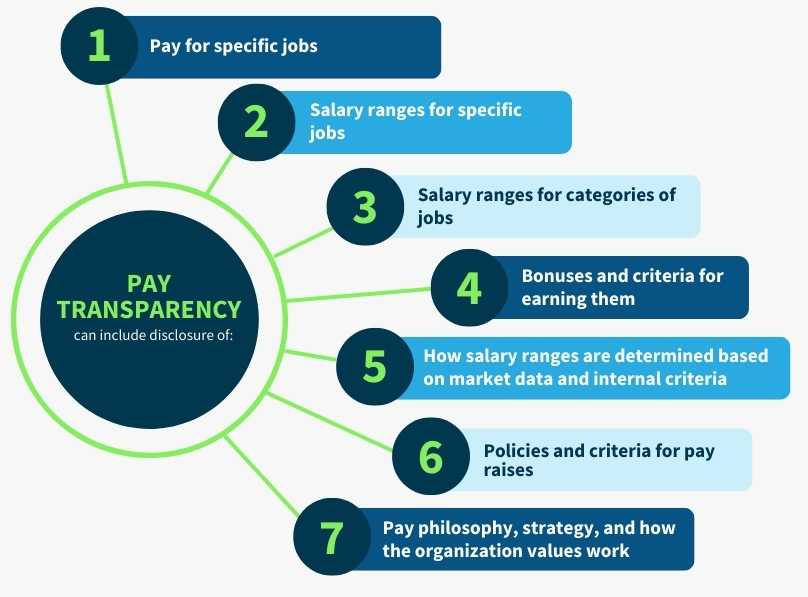What is Pay Transparency

At Salary.com, we care about pay equity. Pay transparency is an important part of understanding and improving pay equity. Our products are designed for HR teams and leaders to compare jobs and compensation and discover and address potential pay gaps. We make is easy to monitor, assess, and understand pay equity inside your organization.
What is pay transparency
Pay transparency is when an employer is open and clear about pay for jobs at the organization and why people are paid what they’re paid.
Having a comprehensive view of compensation within an organization and being able to compare jobs, pay, and demographics makes it much easier to maintain pay equity.
When candidates and employees also have a view of pay within the organization, it saves everyone time. People don't apply for jobs they won't take. Current employees can see what others are paid, which helps with planning a career path and retention. And organizations make sure they are paying everyone fairly, competitively, and in compliance with discrimination laws.

What is pay transparency
Pay transparency is when an employer is open and clear about pay for jobs at the organization and why people are paid what they’re paid.
One of the main purposes of pay transparency is to make pay gaps between comparable jobs easier to see and correct. Pay transparency is an important aspect of pay equity because it encourages organizations to review their compensation philosophy, strategies, and practices so that everyone is paid fairly.
Types of Pay Transparency
There are degrees of pay transparency. On one end of the spectrum, organizations may disclose pay ranges for groups of jobs or provide information on request. On the other end there is full pay transparency where pay for everyone in the organization is posted where employees can see it, and everyone understands the basis for their pay.
Most organizations who have some pay transparency fall somewhere in the middle.

Pay transparency can include disclosure of:
- Pay for specific jobs
- Salary ranges for specific jobs
- Salary ranges for categories of jobs
- Bonuses and criteria for earning them
- How salary rangesare determined based on market data and internal criteria
- Policies and criteria for pay raises
- Pay philosophy, strategy, and how the organization values work
Before deciding on an approach to pay transparency, it’s important to understand what is required by state and federal laws and determine whether the organization has potential pay gaps and how to address them.
It's a good idea to get your employment lawyers involved in pay equity analysis and pay transparency decisions so you can reduce risk and be confident that your exploration, analysis, and decision-making is confidential.
Pay Transparency Compliance
In the past few years, some states have enacted pay transparency laws that require employers to give candidates and employees information about pay at the organization. All pay transparency laws require employers to at least disclose salary ranges to candidates applying for jobs during the hiring process. In some states, employers disclose on request. In others, they are required to provide the information, usually by the first interview. In Colorado, the salary range for the role must be included even earlier, in the job posting.
Here are the states that have enacted pay transparency laws as of mid-2022:
- California in 2018: Equal Pay Actprohibits employers from requesting applicants’ salary history and requires that companies provide a salary range to applicants upon request.
- Washington in 2019:Equal Pay and Opportunities Act
- Maryland in 2020: Equal Pay for Equal Work
- Ohio (Toledo and Cincinnati only) in 2020: Pay Equity Act(Toledo), Prohibited Salary Inquiry and Use (Cincinnati)
- Colorado in 2021: Equal Pay for Equal Work Act
- Nevada in 2021: SB 293(unnamed)
- Connecticut in 2021: HB 6380(unnamed)
- Rhode Island (coming in 2023): Rhode Island Equal Pay Law
- New York (coming in 2023) SB S9427A(unnamed)
In addition, California requires that larger employers disclose demographic and pay data to the state. This is similar to an EEO-1 report but also includes W-2 wages for employees.
New legislation that will require organizations to report more detailed pay data is currently being considered by the California legislature. SB 1162 would require employers to report the median and mean pay by race, ethnicity, and gender for each job category. It would also require pay ranges to be included in job postings.
The policy behind requiring disclosure of median and mean pay by demographic category is to track opportunities for employees who have been historically marginalized. If there are no women, minorities, or people with disabilities in leadership, it will show in the required pay data.
Should Your Organization Implement Pay Transparency?
In considering whether to become more transparent about compensation, here are the questions to consider:
-
What level of pay transparency is required?It may be none or you may be in Colorado, California, or somewhere else where some level of pay transparency is mandated.
Once you understand and can comfortably explain your pay practices, and you are clear on where you stand with pay equity, then you are ready to decide what degree of pay transparency makes sense. Here are questions to ask about what level of transparency will work best for your organization.
- What level of pay transparency would we like to have?Your approach to pay transparency should be consistent with your DE&I goals and practices. But since most organizations will have some pay gaps that need to be addressed, you may not be able to get to the level of pay transparency you want until you have tools and processes in place to assess and handle pay equity issues.
- Do we understand where we stand on pay equity now?Before implementing a new pay transparency policy, understand where you stand on pay equity. If the organization creates fanfare but doesn't back it up with action, the new policy could backfire and undermine employee trust.
- How do we currently monitor pay equity?If the organization has never done a pay equity audit or you do a pay equity analysis once a year, you may want to look at more frequent checks so that your pay practices are consistent with your pay transparency. When you open the blinds, people can see what you're doing behind the window.
- How do we intend to address pay gaps?The answer to this question involves compliance, legal, budget and DE&I. One thing to understand is that you can only increase someone's pay to address pay equity; you can't reduce someone's pay to correct wage gaps.
- Are we prepared to answer questions about pay?When you increase pay transparency, people are often curious and want to know more. They definitely want to know how to get a raise. Sometimes they want to know why someone makes more than they do. If the organization is not clear about how they make compensation decisions, what factors matter and why, it's a good idea to first work on your compensation philosophy. Consider the performance the company wants to encourage, how and why people get raises, and what goes into determining pay for different jobs.
- Do our managers understand how to talk about compensation?Cost of living adjustments are easy. The company sets the rate and then implements it. But pay is also based on skills, experience, responsibility, working conditions, and the experience and abilities of the people doing the work. This is harder for people to talk about because it gets personal quickly. Managers may need some training, encouragement, and direction before you set them up for lots of questions about pay.
- What matters in your organization and what gets rewarded?For many organizations, the reasons people are paid what they're paid can be inconsistent based on when people joined, who they work for, whether they are good at advocating for themselves, and what success looks like in the company. If the organization's pay practices have evolved without guidelines or a clear compensation philosophy, it’s critical to address that first before tackling pay transparency.
- What do people want to know about their pay?Ask your managers, payroll, and HR the kinds of questions they get from employees about compensation and pay.
Achieve Pay Transparency with Salary.com
CompAnalyst Pay Equity from Salary.com can help you with both pay equity assessment and pay transparency. CompAnalyst provides the tools needed to standardize job descriptions based on the skills, requirements and competencies for each role, making it easy to create job groups and levels and automate market pricing, so you can compare pay and work and see where there are potential pay gaps.
It also provides easy to understand data on pay within your organization, so you can determine what level of pay transparency will work best.
The Most Important Thing
The goal behind pay transparency is to pay everyone fairly for the work they do. This benefits everyone.
When employees have more information about what a job pays and why, they have the relevant information needed to make decisions about where they want to work and the job they would like next. With additional information about the factors that determine pay, people can start preparing for the next role by developing the skills and experience they need.
When employers are more open about compensation, they can see pay gaps and address them. This reduces potential liability and helps them stay competitive. It also requires organizations to consider compensation principles and consistently apply them to pay decisions. This promotes fair pay. And when more information is available, it builds trust: people can see the organization is doing what it says it would do.
Pay transparency is an essential element of pay equity. And pay equity is fundamental to fair and nondiscriminatory policies and practices. It's also the right thing to do.
To learn more about how to approach pay transparency for your organization, schedule a free consult with our Consulting Team.
Insights You Need to Get It Right







